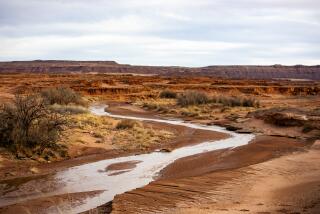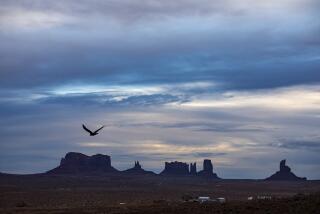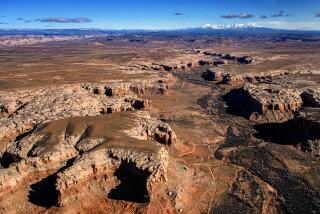A woodsy Northwest retreat gets the water it wanted--with a flood of development.
POINT ROBERTS, Wash. — On the map, Point Roberts looks like a geographer’s mistake: a 5-square-mile peninsula at the northwestern corner of the continental United States that doesn’t seem as if it should be part of America at all.
Isolated on three sides by water and on the fourth by Canada, it dangles south of the border’s 49th parallel like a lonesome toe.
A 19th-Century diplomatic clash assured that Point Roberts and the nearby San Juan Islands would remain part of the United States, but Point Roberts is closer to downtown Vancouver, British Columbia, than to Blaine, Wash., its closest American neighbor.
The result is an unusual bit of real estate caught in a struggle over its future. Should it give in to development pressures from the north, which would surely enrich its slow-moving economy? Or should it remain a tranquil retreat, in the process preserving one of the largest remaining heron rookeries in the Northwest?
Were the peninsula part of Canada, the debate likely would be over. Point Roberts long since would have become a Vancouver suburb. Subdivisions in neighboring Tsawwassen already abut the U.S. border.
Most of the land on the American side is still field and forest, however, in part because Canadian citizens may live in the United States no more than six months a year.
The peninsula has only about 545 permanent residents, but the vacation cabins, beaches and American gasoline prices may attract as many as 20,000 Canadian tourists on a busy summer weekend.
Point Roberts is dependent on its Canadian neighbors in almost every way. It has no doctors, lawyers, large stores or schools. Children make a daily 60-mile round trip, with two border crossings, to attend school in Blaine.
And this year, after decades of negotiation and delay, Point Roberts finally received a reliable supply of water--from a Canadian pipeline.
But “water means development,” said resident Michael Rowan, who is reluctant to see Point Roberts change. “A lot of people who live here have been impoverished, and now they see a chance to make some money.”
The heron rookery is now targeted for logging and construction of an adjacent golf course. Three other logging proposals and plans for a gravel pit, vacation condominiums and home sites and a luxury hotel are also on the drawing boards.
“Point Roberts is a microcosm of what is going on elsewhere,” said Pat Bogdanski, who fled to the peninsula a year ago from Los Angeles. “My canyon (in Los Angeles) became a freeway. It filled up with ugly condominiums and the whole thing was destroyed.” She does not want to see that repeated here.
Margo Johnston, who moved to Point Roberts a year ago to open an art gallery, recalled her first encounter with the heron rookery in the woods. “I heard this incredible noise,” she said. “I didn’t know if it was a tractor or what. It was the heron rookery. The (chicks) make so much noise clamoring for food that it sounds like machinery.”
Ironically, it was development in Canada that pushed the birds across the border in the early 1970s. Now, 650 great blue herons and their approximately 345 nests are packed into an area of 4 acres.
“This is the last rookery, the last stand,” said Evelyn Roth, a Point Roberts artist.
Whatcom County is trying to rezone Point Roberts to bring development under control. “We should have had our plan adopted before the water arrived,” said Dan Taylor, county planning director. “Now, everyone has stars in their eyes. A lot of money is flowing out of Vancouver toward the Point.”
Martin Keeley, one of the leaders of a group called the Heron Preservation Committee, fears that developers will present planners with a fait accompli : cleared land, without herons and ready for building.
Logging proponents, he said, “do not live on the Point and certainly do not seem to care about the quality of life of those who do. They are simply making as much money as they can at our expense.”
There is another side to the debate. Peter Kristiansen, a Canadian whose logging application covers 15 acres that include the heart of the heron rookery, said that when he bought the land as an investment in 1969, there were no birds roosting there. Now that the water supply has made development possible, he said, he is being painted as a bad guy.
“They want us to be down-zoned, and on top of that, they don’t want us to log, either,” said Kim Magnusson, whose mother and father hold 51 acres of forest from a 1902 homestead. “It seems to be herons ahead of people like my parents.”
Shirley Magnusson said that she and her husband, who is 83, need to subdivide the land so they can pay his medical bills. “For years, we looked forward to the day water came to Point Roberts so our worries would subside,” she said.
Other residents fear that what drew them to this unusual place may be lost. “For me, there’s a spiritual quality here that has to do with woods and the ocean and the light and the fields,” said Johnston.
“If they cut down the trees, I won’t be here.”
More to Read
Sign up for Essential California
The most important California stories and recommendations in your inbox every morning.
You may occasionally receive promotional content from the Los Angeles Times.










